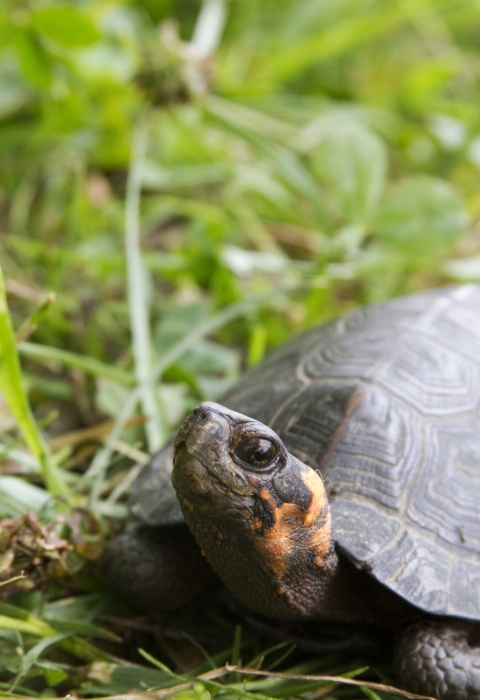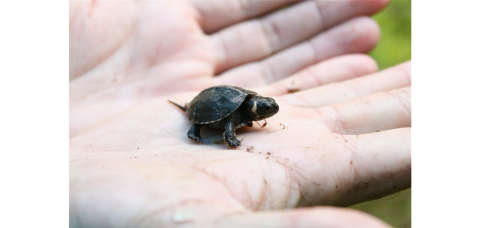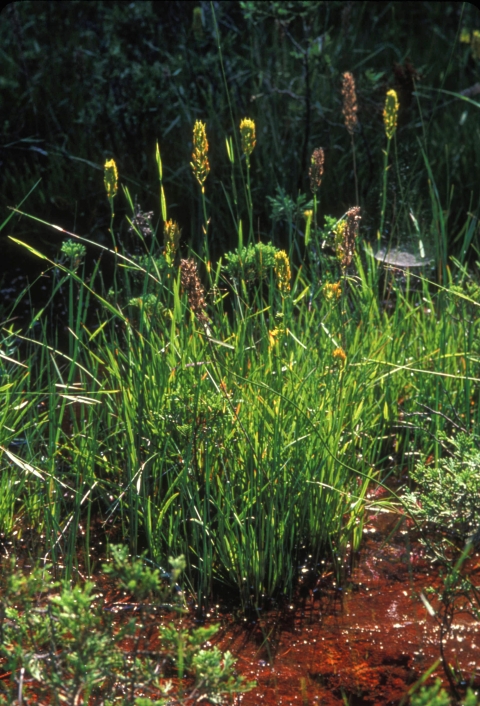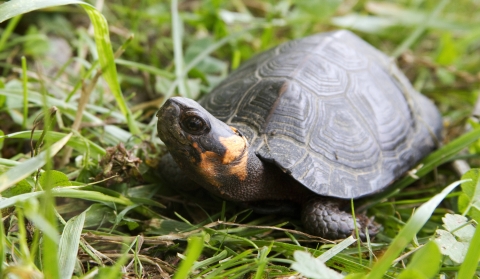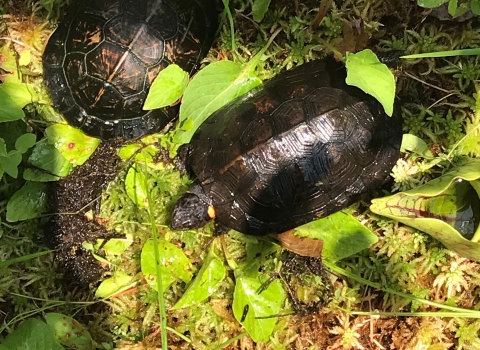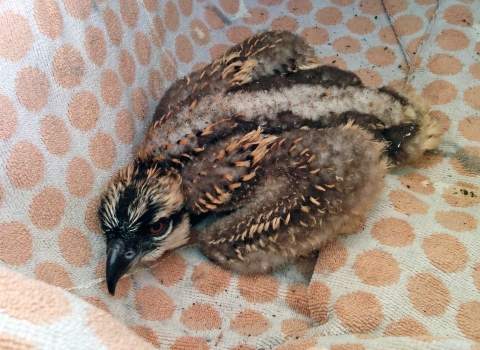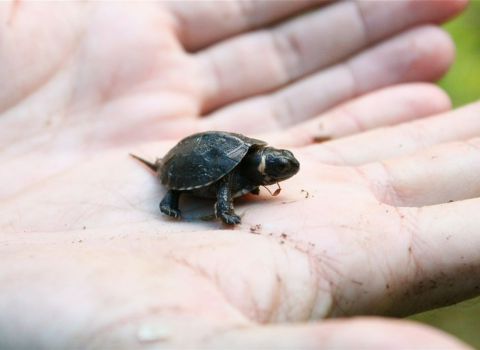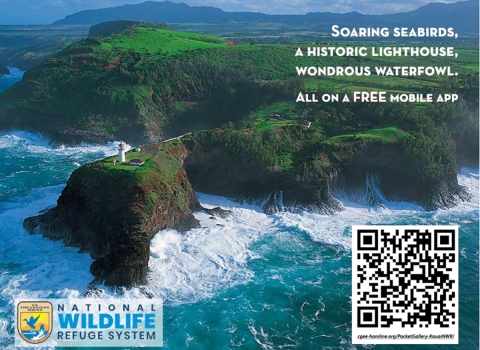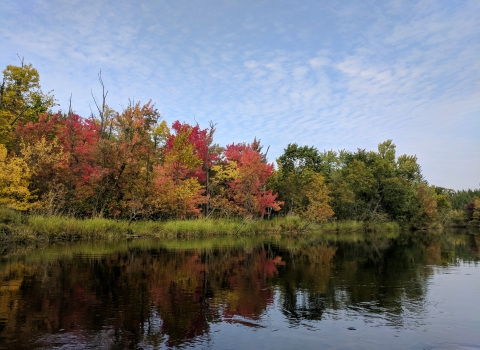The bog turtle may be the smallest turtle species in North America, but it is without a doubt “turtley enough for the turtle club.”
With happy, yellow spots near its tympanic membranes (where the ear holes would be if it had any holes. Not ears, it has ears!), and a diminutive size, it is practically impossible not to utter “aw” at the sight of a bog turtle. Unfortunately, this is a blessing and a curse. Bog turtles are so wonderfully adorable, that some people poach them out of the wild and ship them into the illegal pet trade. Already stressed by the loss and degradation of their wetland habitats, bog turtle populations cannot afford to lose individuals.
Listed as a threatened species under the Endangered Species Act, the bog turtle is protected from collection and possession. Partners help us protect their habitat, in part by finding and acquiring property that may be suitable for these special turtles.
From private property to public protection
It may come as a surprise, but sometimes threatened or endangered species rely on privately owned land for their survival. Across the country, the Service and our partners work to purchase private land from willing landowners for the sake of conserving and recovering federally listed species like the bog turtle.
The bog turtle’s chosen home features beautiful wetland with open forest and some upland areas nearby. Clearly, the turtles don’t know if their community sits on private property or public land — not that that would change their selection of the pristine, quality bog habitat they choose to reside in. However, ensuring their home is safe from development requires cooperation and collaboration between the Service, partners and private landowners.
Private landowners have options to provide safe havens for animals, including threatened and endangered species. There are programs, like the Highlands Conservation Act grant program, that allow the Service and their partners to purchase land for the sake of species conservation. Through the program, conservation agencies working in the Highlands region — an area spanning 3.4 million acres from northwestern Connecticut, through southern New York and northern New Jersey, and into eastern Pennsylvania — may be eligible for funds to help conserve approved areas.
And hey, if your property includes a nice bog, there probably isn’t much development that you would be likely to pursue — hint: the mother-in-law-suite should not go on top of a mucky fen. So, selling the land and having a direct impact on a protected species is a clear win-win!
Managing lands
Other than poaching, a lack of suitable habitat and invasive plant species have been huge threats to these tiny turtles. Mitigating for this problem requires active management of the land. It is not as simple as purchasing a plot, then doing nothing with it, especially when it comes to reed canary grass.
“Reed canary grass forms dense sod that eliminates the open water and tussocks (areas with taller grasses) that bog turtles need. Like typical invasive weeds, it also chokes out every other plant species, forming large monocultures,” said Pennsylvania Department of Conservation and National Resources Forest Manager Steve Wacker.
The Service and partners coordinate efforts to manage acquired land — creating a sustainable balance that serves and protects threatened species like the bog turtle now and into the future.
Spotting potential poaching
Do you or someone you know own property in potential bog turtle habitat? If so, there are several ways to become a bog turtle ally:
“If landowners see people roaming wetlands/bogs on their property without permission, they should consider notifying their local law enforcement agency or their state fish and game law enforcement office to report it — as long as it does not jeopardize one's own safety to do so,” said Service Special Agent Ryan Bessey. “If a strange vehicle is spotted parked near an access area to a property, the owner should safely and discretely record the make, model and registration of the vehicle (pictures are best) and pass that information on to law enforcement.”
People looking for bog turtles will likely carry a staff, walking stick or snake hook (thin metal pole with a curved end) to probe the mud in search of turtles or other reptiles, and are often outfitted with a backpack or satchel.
Special Agent Bessey added, “If people have land with a known or potential bog turtle population, they might consider the use of trail cameras. Not only is it fun to use these cameras to monitor wildlife on your property, it may provide valuable evidence in instances of poaching and/or trespassing and allows owners to monitor potential trespass activity.”
No one should possess a bog turtle. If you suspect someone is illegally collecting or selling wildlife, contact the U.S. Fish and Wildlife Service — through our Wildlife Crime Tips form or by phone at 1-800-344-9453 — or your state wildlife agency. The Service is authorized to pay rewards for information or assistance that leads to an arrest, a criminal conviction, civil penalty assessment, or forfeiture of seized property.
Conservation success story
Communication, collaboration and coordination between the Service, partners and public are key steps to conservation and recovery success. When we all work together and support one another, we achieve the greatest outcomes. Animals great and small are in desperate need of our care and consideration, especially those that are unfortunate enough to find themselves on the threatened and endangered species list.
With each piece of land protected, the Service is closer to meeting key conservation and recovery needs for the bog turtle, including securing 185 populations of the species. Each plot of habitat set aside gives us reason to breathe a small sigh of relief as these little chelonians come out of their adorably small shells and take steps towards recovery!
